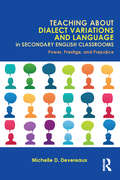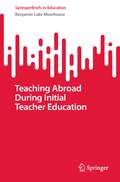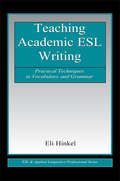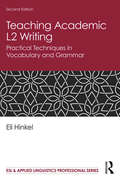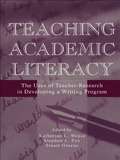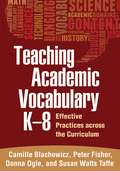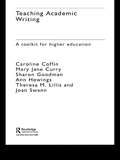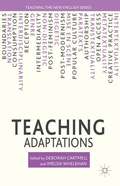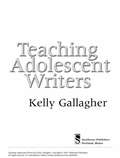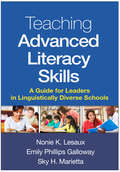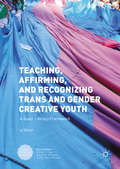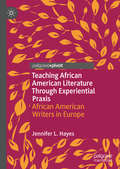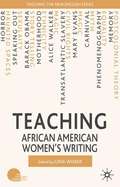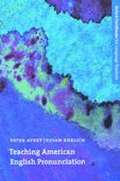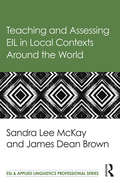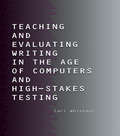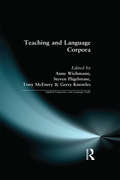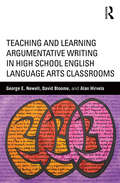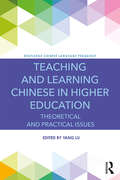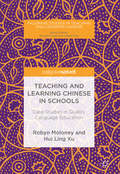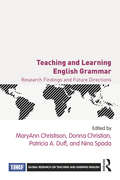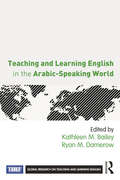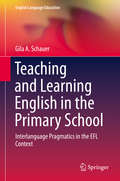- Table View
- List View
Teaching About Dialect Variations and Language in Secondary English Classrooms: Power, Prestige, and Prejudice
by Michelle D. DevereauxStandardized tests demand Standard English, but secondary students (grades 6-12) come to school speaking a variety of dialects and languages, thus creating a conflict between students’ language of nurture and the expectations of school. The purpose of this text is twofold: to explain and illustrate how language varieties function in the classroom and in students’ lives and to detail linguistically informed instructional strategies. Through anecdotes from the classroom, lesson plans, and accessible narrative, it introduces theory and clearly builds the bridge to daily classroom practices that respect students’ language varieties and use those varieties as strengths upon which secondary English teachers can build. The book explains how to teach about language variations and ideologies in the classroom; uses typically taught texts as models for exploring how power, society, and identity interact with language, literature, and students’ lives; connects the Common Core State Standards to the concepts presented; and offers strategies to teach the sense and structure of Standard English and other language variations, so that all students may add Standard English to their linguistic toolboxes.
Teaching Abroad During Initial Teacher Education (SpringerBriefs in Education)
by Benjamin Luke MoorhouseThis book explores teaching abroad during initial teacher education, an increasingly common practice in the initial preparation of teachers. Teaching abroad involves pre-service teachers spending a defined period teaching in a foreign country or in an alternative, and preferably a distinctly different, education system from the one in which they are receiving their initial teacher education. The book, drawing on relevant literature and the author’s first-hand experience of developing and leading a teaching-abroad project, is a concise but comprehensive introduction to the field. Important aspects of the initiative, such as rationale, project designs, benefits, criticisms and limitations, community considerations and future possibilities are included. The book is an important starting point for teacher educators interested in developing teaching abroad projects, as well as academics and scholars interested in the principles, practices, and debates around teaching abroad in initial teacher education.
Teaching Academic ESL Writing: Practical Techniques in Vocabulary and Grammar (ESL & Applied Linguistics Professional Series)
by Eli HinkelTeaching Academic ESL Writing: Practical Techniques in Vocabulary and Grammar fills an important gap in teacher professional preparation by focusing on the grammatical and lexical features that are essential for all ESL writing teachers and student-writers to know. The fundamental assumption is that before students of English for academic purposes can begin to successfully produce academic writing, they must have the foundations of language in place--the language tools (grammar and vocabulary) they need to build a text. This text offers a compendium of techniques for teaching writing, grammar, and lexis to second-language learners that will help teachers effectively target specific problem areas of students' writing. Based on the findings of current research, including a large-scale study of close to 1,500 non-native speakers' essays, this book works with several sets of simple rules that collectively can make a noticeable and important difference in the quality of ESL students' writing. The teaching strategies and techniques are based on a highly practical principle for efficiently and successfully maximizing learners' language gains. Part I provides the background for the text and a sample of course curriculum guidelines to meet the learning needs of second-language teachers of writing and second-language writers. Parts II and III include the key elements of classroom teaching: what to teach and why, possible ways to teach the material in the classroom, common errors found in student prose and ways to teach students to avoid them, teaching activities and suggestions, and questions for discussion in a teacher-training course. Appendices to chapters provide supplementary word and phrase lists, collocations, sentence chunks, and diagrams that teachers can use as needed. The book is designed as a text for courses that prepare teachers to work with post-secondary EAP students and as a professional resource for teachers of students in EAP courses.
Teaching Academic L2 Writing: Practical Techniques in Vocabulary and Grammar (ESL & Applied Linguistics Professional Series)
by Eli HinkelThe new edition of this comprehensive text fills an important role in teacher professional preparation by focusing on how to teach the grammar and vocabulary that are essential for all L2 writing teachers and student-writers. Before L2 writers can begin to successfully produce academic prose, they need to understand the foundations of the language and develop the language tools that will help them build reasonable quality text. Targeting specific problem areas of students’ writing, this text offers a wealth of techniques for teaching writing, grammar, and vocabulary to second-language learners. Updated with current research and recent corpus analysis findings, the second edition features a wealth of new materials, including new teaching activities; student exercises and assignments; and substantially revised appendices with supplementary word and phrase lists and sentence components. Designed for preservice ESL/ELT/TESOL courses as well as Academic Writing and Applied Linguistics courses, this book includes new, contextualized examples in a more accessible and easy-to-digest format.
Teaching Academic Literacy: The Uses of Teacher-research in Developing A Writing Program
by Katherine L. Weese Stephen L. Fox Stuart GreeneTeaching Academic Literacy provides a unique outlook on a first-year writing program's evolution by bringing together a group of related essays that analyze, from various angles, how theoretical concepts about writing actually operate in real students' writing. Based on the beginning writing program developed at the University of Wisconsin-Madison, a course that asks students to consider what it means to be a literate member of a community, the essays in the collection explore how students become (and what impedes their progress in becoming) authorities in writing situations. Key features of this volume include: * demonstrations of how research into specific teaching problems (e.g., the problem of authority in beginning writers' work) can be conducted by examining student work through a variety of lenses such as task interpretation, collaboration, and conference, so that instructors can understand what factors influence students, and can then use what they have learned to reshape their teaching practices; * adaptability of theory and research to develop a course that engages basic writers with challenging ideas; * a model of how a large writing program can be administered, particularly in regards to the integration of research and curriculum development; and * integration of literary and composition theories.
Teaching Academic Vocabulary K-8
by Donna Ogle Peter Fisher Susan Watts Taffe Camille BlachowiczThis book showcases effective ways to build the vocabulary knowledge K-8 learners need to engage meaningfully in reading, writing, and discussion on academic subjects. The distinguished authors draw on decades of classroom experience to explain what academic vocabulary is, how it fits into the Common Core State Standards, and how targeting vocabulary can enhance conceptual understanding in English language arts, social studies, and math and science. Rich classroom vignettes, teaching tips, and examples of student work are included. The book also features helpful figures, word lists, discussion questions, and recommended print and online resources.
Teaching Academic Writing: A Toolkit for Higher Education (Literacies Ser.)
by Caroline Coffin Mary Jane Curry Sharon Goodman Ann Hewings Theresa Lillis Joan SwannStudent academic writing is at the heart of teaching and learning in higher education. Students are assessed largely by what they write, and need to learn both general academic conventions as well as disciplinary writing requirements in order to be successful in higher education.Teaching Academic Writing is a 'toolkit' designed to help higher education lecturers and tutors teach writing to their students. Containing a range of diverse teaching strategies, the book offers both practical activities to help students develop their writing abilities and guidelines to help lecturers and tutors think in more depth about the assessment tasks they set and the feedback they give to students. The authors explore a wide variety of text types, from essays and reflective diaries to research projects and laboratory reports. The book draws on recent research in the fields of academic literacy, second language learning, and linguistics. It is grounded in recent developments such as the increasing diversity of the student body, the use of the Internet, electronic tuition, and issues related to distance learning in an era of increasing globalisation.Written by experienced teachers of writing, language, and linguistics, Teaching Academic Writing will be of interest to anyone involved in teaching academic writing in higher education.
Teaching Accelerated and Corequisite Composition
by David StarkeyTeaching Accelerated and Corequisite Composition is the first book to compile on-the-ground advice and teaching strategies specifically curated for accelerated and corequisite writing courses. Trailblazers in the field from colleges across the United States—who developed a foundation for corequisites by facilitating equity and accessibility for marginalized students—speak to a range of topics and demographics, offering support for instructors and practical advice for improving student success. The book primarily explores accelerated composition through the lens of two-year colleges to answer a central question in the field: to what extent do educators need to alter two-year college curricular design? The contributors also delve into assessment, a crucial process for instructors and their students transitioning to accelerated learning; the key role that reading plays in the writing process; and noncognitive learning, an area of study that has been associated with accelerated learning since its inception. Together these thirteen chapters provide instructors with a strategic approach to teaching accelerated and corequisite composition. Teaching Accelerated and Corequisite Composition points toward a new way of approaching first-year composition: a method of instruction that fosters the growth and success of writers who were once considered underprepared for college writing and are now achieving unprecedented success.
Teaching Adaptations
by Deborah Cartmell Imelda WhelehanTeaching Adaptations addresses the challenges and appeal of teaching popular fiction and culture, video games and new media content, which serve to enrich the curriculum, as well as exploit the changing methods by which English students read and consume literary and screen texts.
Teaching Adolescent Writers
by Kelly GallagherIn an increasingly demanding world of literacy, it has become critical that students know how to write effectively. From the requirements of standardized tests to those of the wired workplace, the ability to write well, once a luxury, has become a necessity. Many students are leaving school without the necessary writing practice and skills needed to compete in a complex and fast-moving Information Age. Unless we teach them how to run with it, they are in danger of being run over by a stampede—a literacy stampede. In Teaching Adolescent Writers, Kelly Gallagher, author of Reading Reasons and Deeper Reading, shows how students can be taught to write effectively. Kelly shares a number of classroom-tested strategies that enable teachers to: - understand the importance of teaching writing; - motivate young writers; - see the importance modeling plays in building young writers (modeling from both the teacher and from real-world text); - understand how providing choice elevates adolescent writing (and how to allow for choice within a rigorous curriculum); - help students recognize the importance of purpose and audience; - assess essays in ways that drive better writing performance. Infused with humor and illuminating anecdotes, Kelly draws on his classroom experiences and work as co-director of a regional writing project to offer teachers both practical ways to incorporate writing instruction into their day and compelling reasons to do so.
Teaching Advanced Literacy Skills: A Guide for Leaders in Linguistically Diverse Schools
by PhD Nonie K. Lesaux Emily Phillips Galloway Sky H. MariettaIn our knowledge-based society, K-8 students need to develop increasingly sophisticated skills to read, write, and speak for a wide variety of purposes and audiences. Including an extended case example from a linguistically diverse school, this book guides school leaders to design and implement advanced literacy instruction through four key shifts: strengthening the instructional core, giving data a central role, using a shared curriculum, and providing supportive and tailored professional development. Reproducible forms and templates facilitate planning and implementation of schoolwide initiatives. Purchasers get access to a Web page where they can download and print the reproducible materials in a convenient 8 1/2" x 11" size.
Teaching, Affirming, and Recognizing Trans and Gender Creative Youth: A Queer Literacy Framework (Queer Studies and Education)
by Sj MillerWinner of the 2018 Outstanding Book by the Michigan Council Teachers of EnglishChoice magazine as an Outstanding Academic Title for 2018Winner of the 2017 AERA Division K (Teaching and Teacher Education) Exemplary Research AwardThis book draws upon a queer literacy framework to map out examples for teaching literacy across pre-K-12 schooling. To date, there are no comprehensive Pre-K-12 texts for literacy teacher educators and theorists to use to show successful models of how practicing classroom teachers affirm differential (a)gender bodied realities across curriculum and schooling practices. This book aims to highlight how these enactments can be made readily conscious to teachers as a reminder that gender normativity has established violent and unstable social and educational climates for the millennial generation of lesbian, gay, bisexual, transgender, intersex, (a)gender/(a)sexual, gender creative, and questioning youth.
Teaching African American Literature Through Experiential Praxis: African American Writers in Europe
by Jennifer L. HayesThis book focuses on teaching African American literature through experiential praxis. Specifically, the book presents several canonical African American literature authors in a study abroad context. The book chapters consider the historical implications of travel within the African American literature tradition including slave narratives, migration narratives, and expatriate narratives. The book foregrounds this tradition and includes activities, rhetorical prompts, and thematic discussion that support instruction.
Teaching African American Women's Writing
by Gina WiskerThe essays in Teaching African American Women's Writing provide reflections on issues, problems and pleasures raised by studying the texts. They will be of use to those teaching and studying African American women's writing in colleges, universities and adult education groups as well as teachers involved in teaching in schools to A level.
Teaching American English Pronunciation
by Peter Avery Susan EhrlichUnlike books aimed at linguistics students or individual learners of English, Teaching American English Pronunciation specifically addresses the needs of ESL teachers. It provides the descriptive knowledge needed to teach pronunciation effectively. But it is also full of practical teaching ideas. The book is divided into three main parts: - Part One is an introduction to the English sound system. It covers spelling and pronunciation, the individual sounds of English, English sounds in context, the shape of English words, word stress and vowel reduction, and connected speech. Throughout this part of the book, the authors use examples of typical errors made by ESL students to illustrate the descriptions and concepts they describe. - Part Two describes the pronunciation problems that most ESL students have with English vowels, consonants, stress, rhythm, and intonation. It then goes on to look at the specific pronunciation problems of speakers of fifteen different languages: Arabic, Chinese, Farsi, French, German, Greek, Hindi and Punjabi, Italian, Japanese, Korean, Polish, Portuguese, Spanish, and Vietnamese. - Part Three consists of a set of articles about practical issues in pronunciation teaching. These are written by ten North American teachers and language researchers with a wide range of experience of teaching in many different contexts. The topics covered include: pronunciation syllabus design, pronunciation-based listening activities, developing self-correcting and self-monitoring strategies, and drama techniques in the pronunciation class.
Teaching and Assessing EIL in Local Contexts Around the World (ESL & Applied Linguistics Professional Series)
by Sandra Lee Mckay James Dean BrownEnglish today is a global language embedded in a great variety of social contexts, resulting in linguistic and pedagogical variation. Taking a new look at the teaching and assessing of English as an international language (EIL), this text highlights overarching principles and provides specific strategies for responding to questions and challenges posed by the changing demographics of English language learners and users around the world. Teaching and Assessment in EIL Classrooms introduces an original, coherent framework in which needs analysis, pedagogical principles, and assessment are integrated describes variables that influence effective teaching and assessment and the characteristics of various EIL teachers and learners emphasizes that pedagogical and assessment decisions need to be based on the learning and teaching needs of each specific EIL context includes specific principles and strategies for teaching and assessing grammar, oral language, and literacy skills in EIL classrooms provides strategies for integrating computer-mediated language into EIL classrooms in ways that promote cross-cultural awareness, language development, and individualized learning Timely, accessible, and practical, this text for graduate and pre- and in-service courses on language teaching and assessment is at the forefront in providing valuable information and guidance for enabling principled and context-sensitive praxis in EIL classrooms worldwide.
Teaching and Evaluating Writing in the Age of Computers and High-Stakes Testing
by Carl WhithausThis book takes on a daunting task: How do writing teachers continue to work toward preparing students for academic and real-world communication situations, while faced with the increasing use of standardized high-stakes testing? Teachers need both the technical ability to deal with this reality and the ideological means to critique the information technologies and assessment methods that are transforming the writing classroom.Teaching and Evaluating Writing in the Age of Computers and High-Stakes Testing serves this dual need by offering a theoretical framework, actual case studies, and practical methods for evaluating student writing. By examining issues in writing assessment--ranging from the development of electronic portfolios to the impact of state-wide, standards-based assessment methods on secondary and post-secondary courses--this book discovers four situated techniques of authentic assessment that are already in use at a number of locales throughout the United States. These techniques stress:*interacting with students as communicators using synchronous and asynchronous environments;*describing the processes and products of student learning rather than enumerating deficits;*situating pedagogy and evaluation within systems that incorporate rather than exclude local variables; and*distributing assessment among diverse audiences.By advocating for a flexible system of communication-based assessment in computer-mediated writing instruction, this book validates teachers' and students' experiences with writing and also acknowledges the real-world weight of the new writing components on the SAT and ACT, as well as on state-mandated standardized writing and proficiency exams.
Teaching and Language Corpora: Papers From The Third International Conference On Teaching And Language Corpora (Applied Linguistics and Language Study #Vol. 2)
by Anne Wichmann Steven FligelstoneCorpora are well-established as a resource for language research; they are now also increasingly being used for teaching purposes. This book is the first of its kind to deal explicitly and in a wide-ranging way with the use of corpora in teaching. It contains an extensive collection of articles by corpus linguists and practising teachers, covering not only the use of data to inform and create teaching materials but also the direct exploitation of corpora by students, both in the study of linguistics in general and in the acquisition of proficiency in individual languages, including English, Welsh, German, French and Italian. In addition, the book offers practical information on the sources of corpora and concordances, including those suitable for work on non-roman scripts such as Greek and Cyrillic.
Teaching and Learning Arabic Grammar: Theory, Practice, and Research
by Kassem M. Wahba Zeinab A. Taha Manuela E. B. GiolfoFoundational and comprehensive, this volume provides a theoretical and practical overview of the current issues that dominate the field of teaching and learning Arabic grammar. Bringing together authorities on Arabic grammar from around the world, the book covers both historical contexts and current practices, and provides principles, strategies, and examples of current Arabic grammar instruction across educational settings. Chapter authors offer a range of perspectives on teaching approaches, implementing research findings in the classroom, and future challenges. A much-needed volume to help students, teachers, and teacher educators develop their knowledge and skills, it addresses the most salient and controversial issues in the field, including: what grammar to teach, how much grammar to teach, how to address grammar in content-based or communication-based classroom, and how to teach variation in grammar. This resource is ideal for preservice Arabic language teachers as well as Arabic language professors and researchers.
Teaching and Learning Argumentative Writing in High School English Language Arts Classrooms
by George E. Newell David Bloome Alan HirvelaFocused on the teaching and learning argumentative writing in grades 9-12, this important contribution to literacy education research and classroom practice offers a new perspective, a set of principled practices, and case studies of excellent teaching. The case studies illustrate teaching and learning argumentative writing as the construction of knowledge and new understandings about experiences, ideas, and texts. Six themes key to teaching argumentative writing as a thoughtful, multi‐leveled practice for deep learning and expression are presented: teaching and learning argumentative writing as social practice, teachers’ epistemological beliefs about argumentative writing, variations in instructional chains, instructional conversations in support of argumentative writing as deep learning and appreciation of multiple perspectives, contextualized analysis of argumentative writing, and the teaching and learning of argumentative writing and the construction of rationalities.
Teaching and Learning Chinese in Higher Education: Theoretical and Practical Issues (Routledge Chinese Language Pedagogy)
by Yang LuTeaching and Learning Chinese in Higher Education deals with the current issues and challenges faced by teachers and learners of Chinese. Written by leading professionals and academics, the book is the first collection of research articles based on data collected in higher education institutions in the UK. The studies focus on concerns related to learners of Chinese as a foreign language (CFL) and aim to establish studies on teaching Chinese as a foreign language (TCFL) as part of the mainstream of applied linguistics The contributors have applied their theoretical backgrounds in applied linguistics and education to tackle issues such as how to benchmark the Chinese written language with CEFR, how to integrate standardised Chinese proficiency tests with institutional assessments and teaching methodologies. Teaching and Learning Chinese in Higher Education will be invaluable to professionals, academics and students seeking theoretical frameworks in applied linguistics for TCFL.
Teaching and Learning Chinese in Schools: Case Studies In Quality Language Education (Palgrave Studies in Teaching and Learning Chinese)
by Hui Ling Xu Robyn MoloneyThis book presents the principles of quality teaching in Chinese, as exemplified in case studies of primary and secondary school classrooms. Drawing on data from five Australian schools, the authors identify the key practices necessary to produce a quality learning experience for students. The book offers a thorough grounding in the issues involved in teaching different age groups, and many practical strategies, including a comprehensive overview of digital technologies for teaching and learning Chinese. It will provide a valuable resource for students and scholars of applied linguistics, in addition to supporting teacher training and professional development.
Teaching and Learning English Grammar: Research Findings and Future Directions (Global Research on Teaching and Learning English)
by Nina Spada Donna Christian Patricia A. Duff MaryAnn ChristisonAn important contribution to the emerging body of research-based knowledge about English grammar, this volume presents empirical studies along with syntheses and overviews of previous and ongoing work on the teaching and learning of grammar for learners of English as a second/foreign language. It explores a variety of approaches, including form-focused instruction, content and language integration, corpus-based lexicogrammatical approaches, and social perspectives on grammar instruction. Nine chapter authors are Priority Research Grant or Doctoral Dissertation Grant awardees from The International Research Foundation for English Language Education (TIRF), and four overview chapters are written by well-known experts in English language education. Each research chapter addresses issues that motivated the research, the context of the research, data collection and analysis, findings and discussion, and implications for practice, policy, and future research. The TIRF-sponsored research was made possible by a generous gift from Betty Azar. This book honors her contributions to the field and recognizes her generosity in collaborating with TIRF to support research on English grammar. Teaching and Learning English Grammar is the second volume in the Global Research on Teaching and Learning English Series, co-published by Routledge and TIRF.
Teaching and Learning English in the Arabic-Speaking World: Teaching And Learning English In The Arabic-speaking World (Global Research on Teaching and Learning English)
by Kathleen M. Bailey Ryan M. DamerowCo-published with The International Research Foundation for English Language Education (TIRF) An important contribution to the emerging body of research-based knowledge about teaching English to native speakers of Arabic, this volume presents empirical studies carried out in Egypt, Lebanon, Oman, Palestine, Saudi Arabia, and the United Arab Emirates (UAE)—a region which has gained notable attention in the past few decades. Each chapter addresses an issue of current concern, and each includes implications for policy, practice, and future research. Nine chapter authors are Sheikh Nahayan Fellows—recipients of doctoral fellowships from The International Research Foundation for English Language Education (TIRF). This volume is the first in the Global Research on Teaching and Learning English Series, co-published by Routledge and TIRF.
Teaching and Learning English in the Primary School: Interlanguage Pragmatics in the EFL Context (English Language Education #18)
by Gila A. SchauerThis book is the first comprehensive investigation of interlanguage pragmatic issues in a primary school context that is based on both primary school teachers’ statements on their own teaching realities, views and preferences, and a thorough investigation of materials used by teachers and recommended by teacher educators in the state the primary schools are located in. It offers a contrastive analysis of primary school learners acquiring English in a typical English as a foreign language school context and their age peers in the same state that are exposed to English in a school immersion context. This book will be of interest to scholars, researchers, educators in higher education that focus on English language teaching, second language acquisition and applied linguistics. It is also intended for students who are planning to become primary school teachers of English as a foreign language.
